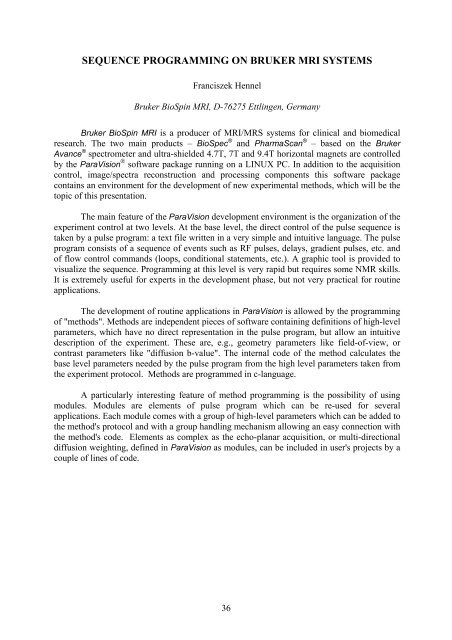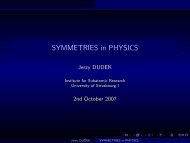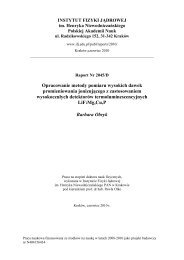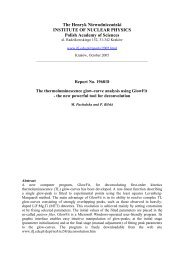Report No xxxx - Instytut Fizyki JÄ drowej PAN
Report No xxxx - Instytut Fizyki JÄ drowej PAN
Report No xxxx - Instytut Fizyki JÄ drowej PAN
Create successful ePaper yourself
Turn your PDF publications into a flip-book with our unique Google optimized e-Paper software.
SEQUENCE PROGRAMMING ON BRUKER MRI SYSTEMS<br />
Franciszek Hennel<br />
Bruker BioSpin MRI, D-76275 Ettlingen, Germany<br />
Bruker BioSpin MRI is a producer of MRI/MRS systems for clinical and biomedical<br />
research. The two main products – BioSpec ® and PharmaScan ® – based on the Bruker<br />
Avance ® spectrometer and ultra-shielded 4.7T, 7T and 9.4T horizontal magnets are controlled<br />
by the ParaVision ® software package running on a LINUX PC. In addition to the acquisition<br />
control, image/spectra reconstruction and processing components this software package<br />
contains an environment for the development of new experimental methods, which will be the<br />
topic of this presentation.<br />
The main feature of the ParaVision development environment is the organization of the<br />
experiment control at two levels. At the base level, the direct control of the pulse sequence is<br />
taken by a pulse program: a text file written in a very simple and intuitive language. The pulse<br />
program consists of a sequence of events such as RF pulses, delays, gradient pulses, etc. and<br />
of flow control commands (loops, conditional statements, etc.). A graphic tool is provided to<br />
visualize the sequence. Programming at this level is very rapid but requires some NMR skills.<br />
It is extremely useful for experts in the development phase, but not very practical for routine<br />
applications.<br />
The development of routine applications in ParaVision is allowed by the programming<br />
of "methods". Methods are independent pieces of software containing definitions of high-level<br />
parameters, which have no direct representation in the pulse program, but allow an intuitive<br />
description of the experiment. These are, e.g., geometry parameters like field-of-view, or<br />
contrast parameters like "diffusion b-value". The internal code of the method calculates the<br />
base level parameters needed by the pulse program from the high level parameters taken from<br />
the experiment protocol. Methods are programmed in c-language.<br />
A particularly interesting feature of method programming is the possibility of using<br />
modules. Modules are elements of pulse program which can be re-used for several<br />
applications. Each module comes with a group of high-level parameters which can be added to<br />
the method's protocol and with a group handling mechanism allowing an easy connection with<br />
the method's code. Elements as complex as the echo-planar acquisition, or multi-directional<br />
diffusion weighting, defined in ParaVision as modules, can be included in user's projects by a<br />
couple of lines of code.<br />
36

















